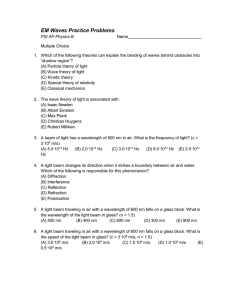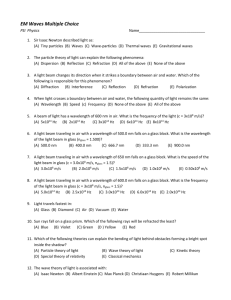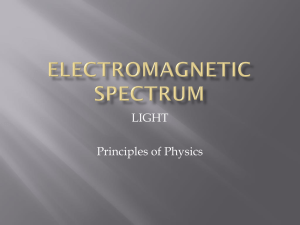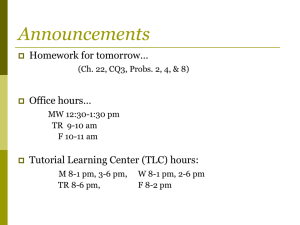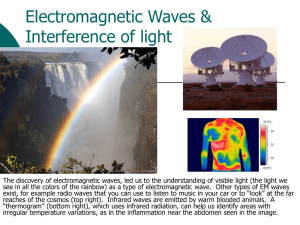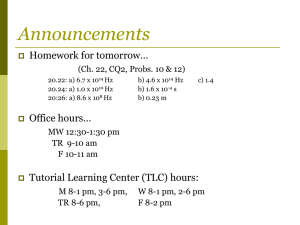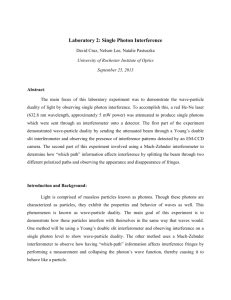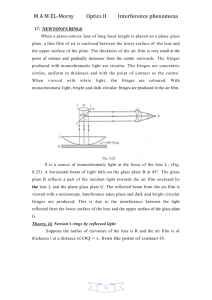EM Waves Practice Problems
advertisement
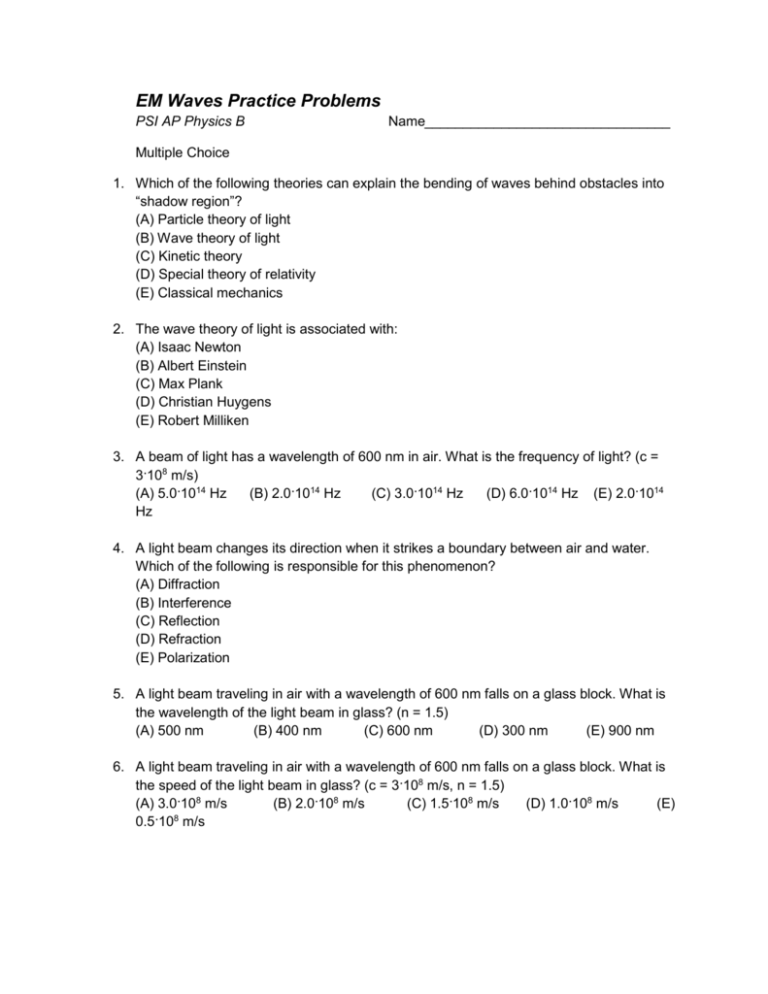
EM Waves Practice Problems PSI AP Physics B Name________________________________ Multiple Choice 1. Which of the following theories can explain the bending of waves behind obstacles into “shadow region”? (A) Particle theory of light (B) Wave theory of light (C) Kinetic theory (D) Special theory of relativity (E) Classical mechanics 2. The wave theory of light is associated with: (A) Isaac Newton (B) Albert Einstein (C) Max Plank (D) Christian Huygens (E) Robert Milliken 3. A beam of light has a wavelength of 600 nm in air. What is the frequency of light? (c = 3·108 m/s) (A) 5.0·1014 Hz (B) 2.0·1014 Hz (C) 3.0·1014 Hz (D) 6.0·1014 Hz (E) 2.0·1014 Hz 4. A light beam changes its direction when it strikes a boundary between air and water. Which of the following is responsible for this phenomenon? (A) Diffraction (B) Interference (C) Reflection (D) Refraction (E) Polarization 5. A light beam traveling in air with a wavelength of 600 nm falls on a glass block. What is the wavelength of the light beam in glass? (n = 1.5) (A) 500 nm (B) 400 nm (C) 600 nm (D) 300 nm (E) 900 nm 6. A light beam traveling in air with a wavelength of 600 nm falls on a glass block. What is the speed of the light beam in glass? (c = 3·108 m/s, n = 1.5) (A) 3.0·108 m/s (B) 2.0·108 m/s (C) 1.5·108 m/s (D) 1.0·108 m/s (E) 8 0.5·10 m/s 7. A light beam traveling in air with a wavelength of 600 nm falls on a glass block. What is the frequency of the light beam in glass? (c = 3·108 m/s, n = 1.5) (A) 5.0·1014 Hz (B) 2.5·1014 Hz (C) 3.0·1014 Hz (D) 6.0·1014 Hz (E) 2.0·1014 Hz 8. Which of the following is the correct order of electro-magnetic radiation with an increasing frequency? (A) Radio Waves, Visible Light, IR Radiation, UV Radiation, X-Rays, γ –Rays (B) γ –Rays, Visible Light, IR Radiation, UV Radiation, X-Rays, Radio Waves (C) Radio Waves, UV Radiation, Visible Light, IR Radiation, X-Rays, γ –Rays (D) Radio Waves, Visible Light, X-Rays, IR Radiation, UV Radiation, γ –Rays (E) Radio Waves, IR Radiation, Visible Light, UV Radiation, X-Rays, γ –Rays 9. A light beam spreads when it travels through a narrow slit. Which of the following can explain this phenomenon? (A) Polarization (B) Reflection (C) Dispersion (D) Diffraction (E) Refraction 10. In Young’s double-slit experiment a series of bright and dark lines was observed. Which of the following principles is responsible for this phenomenon? (A) Polarization (B) Reflection (C) Dispersion (D) Interference (E) Refraction 11. Which of the following electro-magnetic waves can be diffracted by a building? (A) Radio waves (B) Infrared waves (C) Ultraviolet waves (D) Visible light Waves (E) γ- 12. A blue beam of light falls on two narrow slits producing an interference pattern on a screen. If instead blue light a red beam of light was used in the same experiment, which new changes to the interference pattern we can observe? (A) Interference fringes move close to the central maximum (B) Interference fringes move away from the central maximum (C) No change in interference (D) Bright fringes are replaced with dark fringes (E) The number of fringes increases 13. In a Young’s double-slit experiment interference pattern is observed on a screen. The apparatus is then submerged into water. What is the new change in the interference pattern? (A) Interference fringes move close to the central maximum (B) Interference fringes move away from the central maximum (C) No change in interference (D) Bright fringes are replaced with dark fringes (E) The number of fringes increases 14. Two coherent light waves approaching a certain point on a screen produce a constructive interference. The optical extra distance traveled by one of the waves is: (A) λ/2 (B) λ/3 (C) 3λ/2 (D) λ (E) 5λ/2 15. In a Young’s double-slit experiment the distance between the slits increases. What happens to the separation between the fringes? (A) Increases (B) Decreases (B) Stays the same (D) Increases for the bright fringes and decreases for the dark fringes (E) Increases for the dark fringes and decreases for the bright fringes 16. In a double-slit experiment a distance between the slits is doubled. What happens to the separation between the two adjacent maxima? (A) Doubles (B) Quadruples (C) Is cut to a half (D) Is cut to a quarter (E) Stays the same 17. In a single-slit experiment as a result of interference of a laser beam a student observes a set of red and dark concentric circles. When he increases the slit separation what happens to the interference pattern? (A) The separation between the circles increases (B) The separation between the circles decreases (C) No change in interference pattern (D) The separation between the circles increases and then decreases (E) The separation between the circles decreases and then increases 18. A light beam falls on a thin film and partially reflects from the film and partially transmits through the film. What is the phase difference between the reflected and transmitted waves? (A) λ (B) 2λ (C)λ/3 (D) λ/4 (E) λ/2 19. A light beam traveling in water enters air. What is the phase difference between the incident and transmitted waves? (A) 0 (B) 2λ (C) λ/3 (D) λ/4 (E) λ/2 20. A light beam of coherent waves with a wavelength of 600 nm falls perpendicularly on a diffraction grating. The separation between two adjacent slits is 1.8 µm. What is the maximum number of spectral orders can be observed on a screen? (A) 1 (B) 2 (C) 3 (D) 4 (E) 5 21. Sun rays fall on a glass prism. Which of the following rays will be refracted the least? (A) Blue (B) Violet (C) Green (D) Yellow (E) Red 22. Unpolarized light passes through two Polaroids; the axis of one is vertical and that of the other is 60 ̊ to the vertical. If the intensity of the incident light is I0, what is the intensity of the transmitted light? (A) I0 (B) I0 /4 (C) I0/3 (D) I0/2 (E) I0/8 Free Response Problems 1. Coherent monochromatic light falls normally on two slits separated by a distance d = 2.2 mm. The interference pattern is observed on a screen L = 4 m from the slits. a. What is the result of the interference at point A? b. What is the wavelength of the incident light? c. Determine the angular width between two second order maxima. d. If one of the slits is covered with a glass block and two waves emerge from the slits 180 ̊ out of phase. Describe the interference pattern on the screen. 2. In a double-slit experiment sun rays are incident on two narrow slits 2.4 mm apart. Colored fringes are observed on a detector screen 2 m away from the slits. ( λviolet = 400 nm, λred = 700 nm) a. Determine the path difference between two blue waves arriving to the first order maximum. b. Determine the path difference between two red waves arriving to the first order maximum. c. Determine the width of the second order maximum. d. The entire apparatus is submerged into water with the index of refraction 1.3. Determine the width of the second maximum. 3. Light with two wavelengths λblue = 450 nm and λred = 700 nm is incident on a 6000 lines/cm diffraction grating. Colored interference pattern is observed on a screen 2.5 m away. a. What is the angular width between two blue first order spectrum lines? b. What is the angular width between two blue first order spectrum lines? c. What is the distance between two red and blue spectrum lines in the second order? d. How many spectrum orders of blue light can be seen on the screen? e. How many spectrum orders of red light can be seen on the screen? 4. A glass block n = 1.6 is covered by a thin film n = 1.3. A monochromatic light beam λ= 600 nm initially traveling in air is incident on the film. (Assuming the angel of incidence in small) a. What is the frequency of the incident light? b. What is the wavelength of the light in the film? c. What must be the minimum thickness of the film in order to minimize the intensity of the reflected light? d. What must be the minimum nonzero thickness of the film except in order to maximize the intensity of the reflected light? 5. A soap bubble is illuminated with 480 nm light. The index of refraction of the bubble is 1.3. a. Calculate the frequency of the incident light? b. Calculate the wavelength of light in the film. c. Calculate the minimum thickness of the film required to minimize the intensity of the reflected light. d. Calculate the minimum nonzero thickness of the film required to maximize the intensity of the reflected light. Multiple Choice Answers: 1. 2. 3. 4. B D A D 5. 6. 7. 8. B B C E 9. 10. 11. 12. D D A A 13. 14. 15. 16. A D B C 17. 18. 19. 20. B E A C 21. E 22. E Free Response: Question 1 a) Constructive interference, a bright spot b) c) This is the angle from the center to one of the maxima; the angle between maxima is 0.12o. d) The light and dark spots would be switched. Question 2 a) 400 nm b) 700 nm c) d) You can recalculate with , or you could recognize that this is a distributive property you can just divide by 1.3. Question 3 a) x2 to get angle between maxima = 32o b) (Question should ask for angle between RED first order spectrum lines) x2 to get angle between maxima = 50o c) d) At angles larger than , the lines will no longer be visible (waves won’t interfere because they are not going in same direction) Answer is 3 (will only see m=3, will not see m=4) e) Question 4 a) b) c) d) Question 5 a) b) c) d) Answer is 2 (will only see m=2, will not see m=3)

